Prague is one of Central Europe’s most enchanting and interesting cities. The river Vltava meanders through the city passing several hills and boroughs, each containing unique architectural gems, elegant squares, green oases and everything else that belongs to a big city.
A meeting with Prague is a meeting with one of Europe’s old and large cultural cities. Throughout the streets of the old town you will find nice architecture, large institutional buildings, churches and historical places where emperors and kings have left their mark over the years. The Old City and the New City are located on the eastern side of the river, and together with the Lessor Town and Prague Castle on the western shore, they make the most interesting parts of Prague.
All the neighborhoods offer different sights from each their eras of history, culture and architecture. The often narrow streets are leading from one sight to the other, with experimental modern architecture in contrast to the Gothic and the Baroque styles, which is very visible in Prague with the city’s many churches and noble palaces. The Old Town Town Square, Staroměstské náměstí, is the center of it all and an impressive starting point for it all, and not least for the walk to Charles Bridge and Prague Castle.
There are many great sights close to Prague as well, and a trip in the surrounding area allows you to see everything from the country’s many castles to rich provincial towns, some of them with fashionable facilities like the spa town of Karlovy Vary. Mountains are to the northeast and also relatively close to the capital.
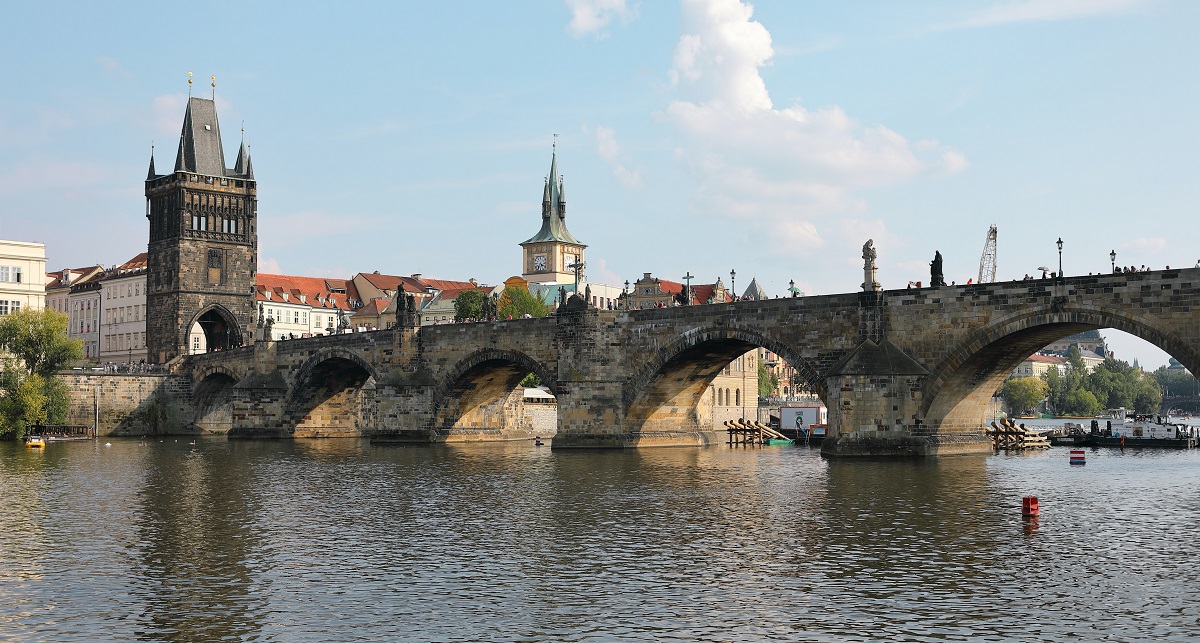
Charles Bridge is one of Prague’s most famous sights and widely famous from countless photographs from the city. It spans the river Vltava, was built in the 14th century and decorated with statues of i.a. Matthias Bernard Braun.
This square is one of the most beautiful and central places in Prague. This is where the city’s old town hall is located, and you can see the Jan Hus Monument and the towers of Church of Our Lady before Týn among many sights here.

This is Prague City Hall, where you can see the famous 15th-century astronomical clock. The 14th century town hall tower is also beautiful, and the views from the tower’s balcony are stunning.
The large Strahov Monastery was founded in 1140 and over time expanded to be among the highlights of Prague. The monastery’s library with the elegantly decorated Theological Hall/Teologický sál is the most famous sight in a complex.

St. Nikolas Church is a very beautiful building from the 18th century. The church is lavishly decorated and is considered Prague’s most beautiful baroque church. Here are statues, frescoes and paintings by the best artists of the time.
Prague Castle is the collective name for the large castle complex, which is beautifully built and majestically elevated above the rest of the city. There are countless sights in the castle, which over time was built as a small town.

This beautiful Gothic cathedral is the Czech Republic’s largest church and a landmark of the city. The cathedral is located in the middle of the city’s castle complex and was built over the centuries with an impressive result. The interior is impressive, as is the exterior design.
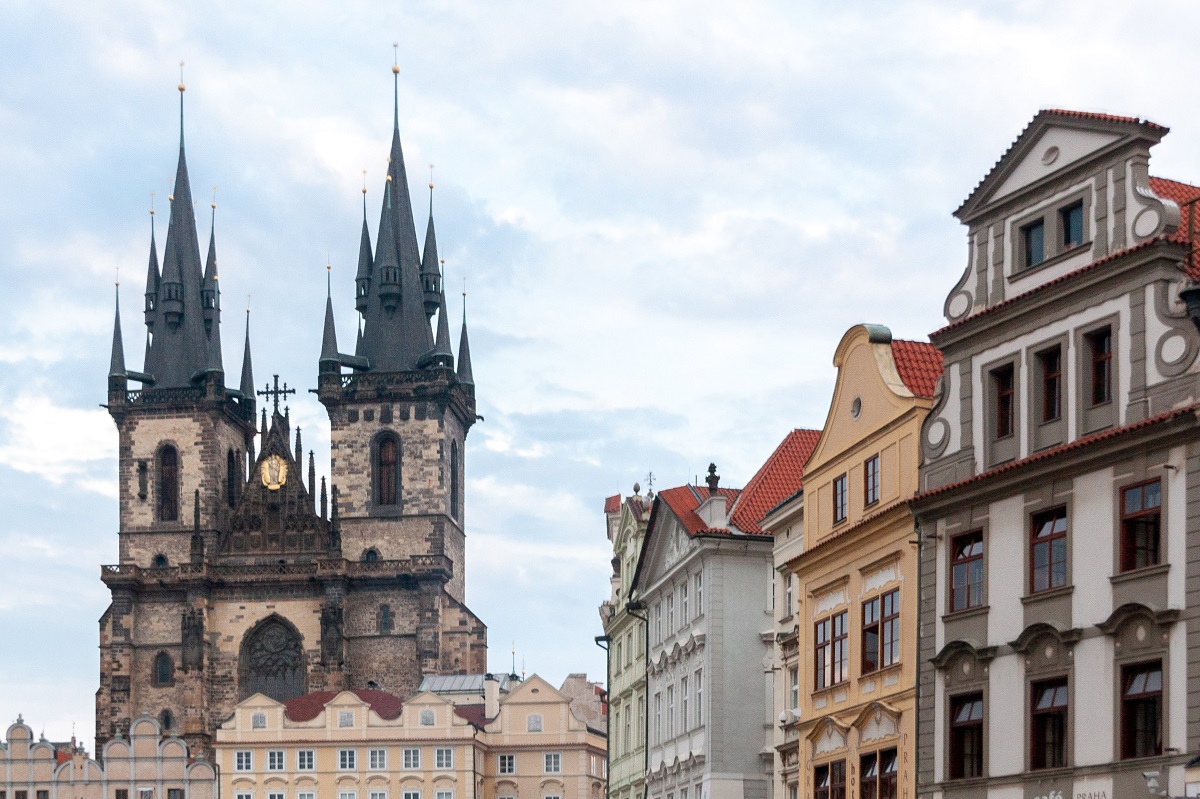
This church is also known as Týn Church. The Gothic silhouette from the 14th century to the 16th century dominates the neighborhood. Týn has a beautiful and contemporary typical church interior, and the Danish astronomer Tycho Brahe is buried here.
The Josefov district is centrally located in Prague, and it is the city’s old Jewish quarter. Much was demolished in the decades around the year 1900, but you can still see a number of old synagogues and the old Jewish cemetery from the 15th century.
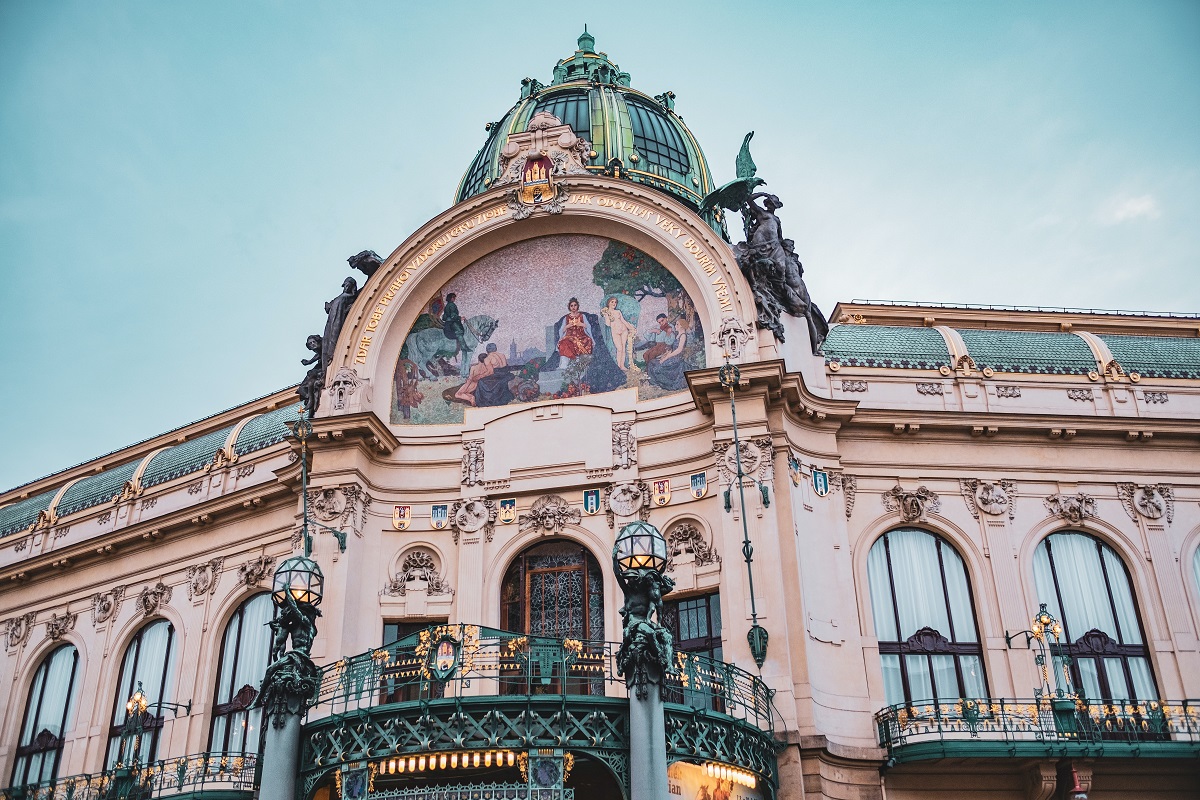
This is a cultural center and showroom in a building known as Prague’s most beautiful Art Nouveau construction. The house was built 1905-1911, and it was here that the country was declared independent in 1918.
Rudolfinum is home to the Prague Philharmonic Orchestra. The building was erected in 1876-1884 and named after the Habsburg prince Rudolf. The fine building became politically historic when it was the seat of the country’s parliament in the years 1918-1939.

This is the Powder Tower, built in 1475 as a coronation gift to Vladislav II, who used an adjoining building as his residence. The tower’s predecessor on the site formed one of the city’s entrance gates.
This is Prague’s main railway station, and at the same time it is a beautiful Art Nouveau building built in the years 1901-1909. The best example of the style can be found in the café area Fantova Kavárna.
Národní Muzeum is the Czech National Museum with a fine collection of millions of finds, stories and effects on countless themes. The impressive museum building was erected for this purpose in 1891
.

This is one of Prague’s most famous squares. In the Middle Ages, it was the town’s horse market. In the square you can see an equestrian statue of St. Wenceslas, which is the country’s national saint, and there are many beautiful buildings around the square.
The Upper Castle is located a little south of the center of Prague and is a complex that was founded in the 10th century on a hill by the river Vltava. Vyšehrad was a residence for a period, while today you can mostly see preserved remains from the fortress on the site. Saint Peter and Paul Basilica / Bazilika svatého Petra a Pavla can also be seen here.
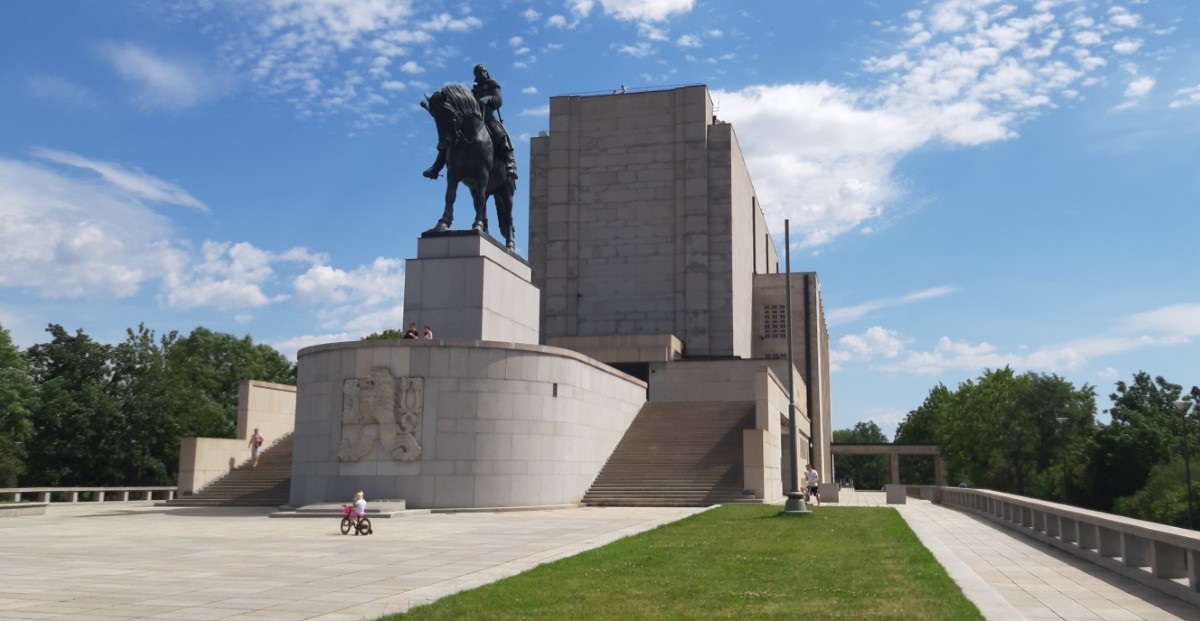
Vitkov is one of the largest and most significant monuments of the 20th century in Prague. The foundation stone was laid in 1928, and since then the monument has been erected and i.a. used as a mausoleum for Communist leader Klement Gottwald.
The Petřín Tower is a 63 meter/208 foot high tower, built in 1891 with inspiration from the Eiffel Tower in Paris. There is an excellent view of the city from the observation platform of the tower.
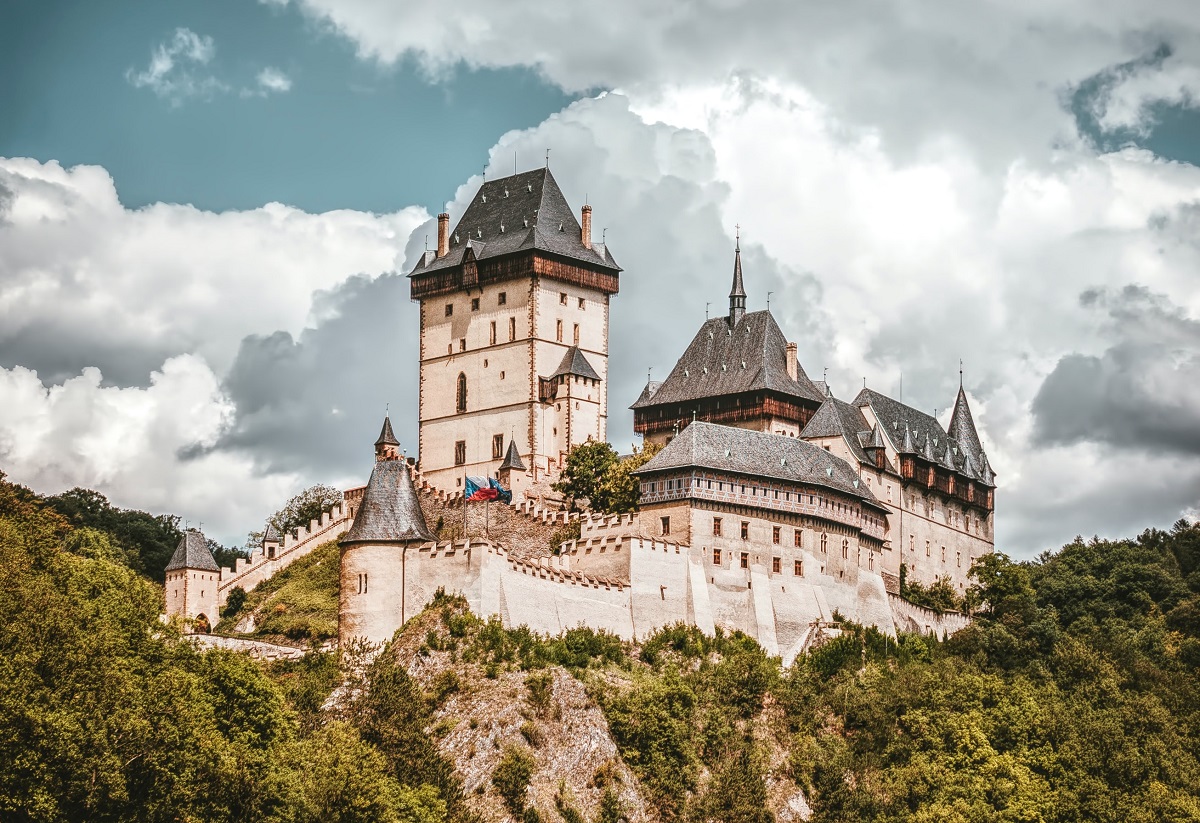
Charles IV’s impressive castle, Karlštejn, is located in beautiful nature southwest of Prague. The castle has historically been the country’s most significant. The castle was founded in 1348, and it is a beautiful construction with its large castle tower and residential buildings etc.
The impressive Koněprusy Caves are the largest stalactite caves in Bohemia. They were discovered in 1950 and are open to visitors with a beautiful underground experience.
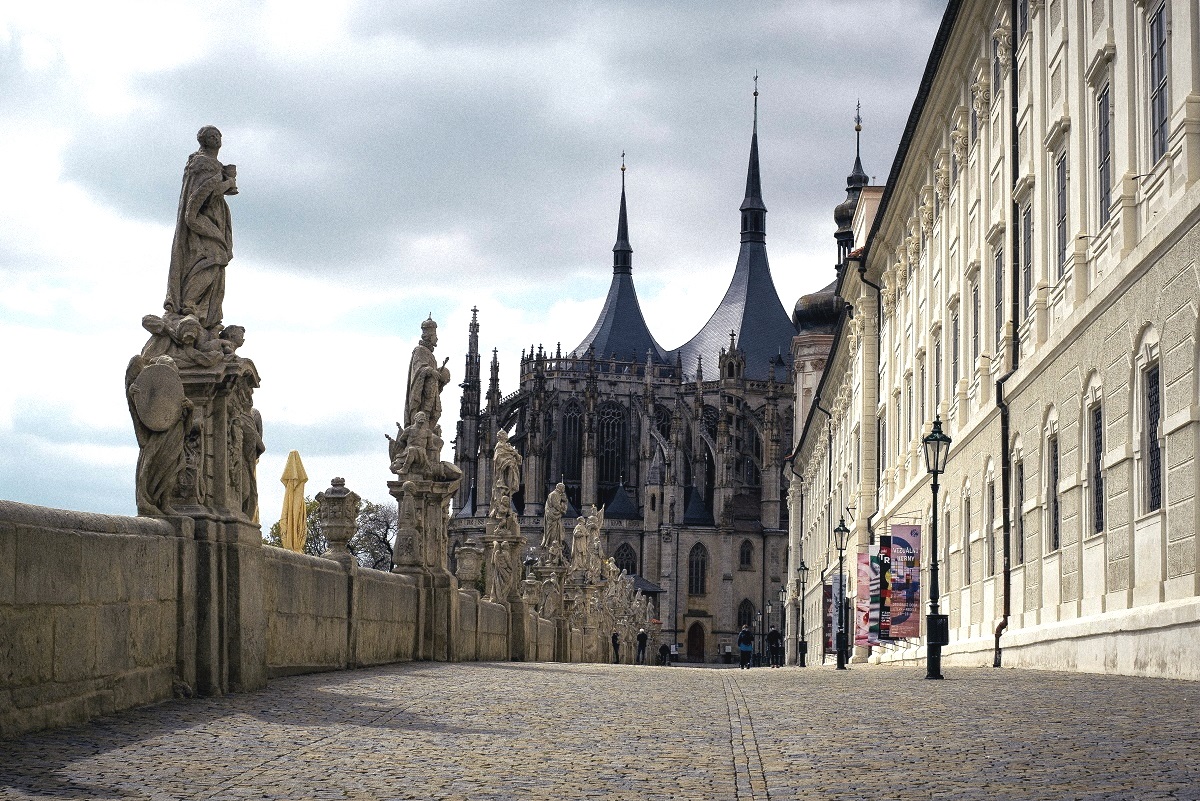
The historic town of Kutná Hora was founded due to the area’s rich silver deposits, and as early as the end of the 13th century it was established as a royal residence. The sights are many and include several churches and the city castle.
By the Elbe and the village of Kuks, you can see the town’s old hospital as a major attraction of the area. The fine baroque building is interesting, and so are the sculptor Matthias Bernard Braun’s beautiful statues.
The city of Terezín was founded in the late 18th century by the Austrian Emperor Joseph II, and was named after Joseph’s mother, Maria Theresia. The city is known for the Theresienstadt concentration camp, which is now a museum.

Karlovy Vary is a famous spa town located west of Prague. It has been visited for centuries for its hot springs, which are 41-72 degrees Celsius/105-161 degrees Fahrenheit. The nature, the culture, the buildings and the warm water are all lovely experiences here.
České Budějovice is the largest city in southern Bohemia. It is a provincial town with a very beautiful and atmospheric city center, where you can see preserved buildings from i.a. the Gothic, Renaissance and Baroque periods.
Václavské náměstí 21
debenhams.cz
Náměstí Republiky 656/8
od-kotva.cz
Nevnická 1
metropole.cz
Veselská 663
oc-letnany.cz
Vinohradská 151
palacflora.cz
Holešovice
Na Příkopě 1
slovanskydum.cz
The streets around Staroměstské náměstí and Václavské náměstí, 28. října, Celetná, Na Příkopě
Muzeum Loutek
Karlova 12
puppetart.com
Mořský svět
Vykkeaviště
morsky-svet.cz
Muzeum hraček
Jiřská 6
muzeumhracek.cz
Zrcadlové bludišté
Petřínské sady
Zoo Praha
U trojského zámku 3/120
zoopraha.cz
Národní technické muzeum
Kostelní 42
ntm.cz
Muzeum MHD
Patočkova 4
dp-praha.cz/en/hist-muz.htm
The Prague area have been inhabited for several millennia, due to the location of the site on the north-south trade routes, which followed the river Vltava.
The first known tribes who settled here were boii who were cellars. They came here about 500 BC, and it is believed that they gave Bohemia its original name.
Well over 500 years later, the Germanic tribe marcomanni came here. Some of the Celts retreated to the south, while others were integrated with the Germans under the leadership of King Maroboduus.
The twentieth century and the following many centuries became the time of the migrants in Europe, and from the mid-500s slaves came to the area, and in time they came to establish Prague and the Czech Republic. Many of the Germanic settlers moved on with the Longobards to the northern Italian region, while the remaining were assimilated among the West Slavs.
According to the accounts, a Czech dynasty was established when Princess Libuše married Přemysl, who came from humble conditions. Libuše reportedly predicted that a large city would rise and reach the stars along the Vltava River and that a castle named Praha would be erected here. Whether the story is true or not must remain uncertain, but Prague Castle was founded in the 8th century, and it became the starting point for the first real city formation.
It was Prince Borivoj of Bohemia who ruled from the second half of the 8th century, and he moved his residence from Levý Hradec to Prague, and since his time he Prague Castle and castle has been the political center of the Czech territory. The castle also became one of Europe’s largest fortified residences.
In 921, Václav, the Czech national saint, first came to power. Prior to his time, Prague and Bohemia were part of the Great Empire, but Václav made approximations to the German Ottoman dynasty to strengthen the influence of the Czechs. The approaches made adversaries, and Václav was assassinated in 929 after eight years as leader.
Václav was saintly ordained and buried in the church he founded at the site of the Václav Chapel of St. Vitus Cathedral today. He was brought up with a Christian father, which was contrary to many of the pagan customs that the nobility held until Christianity took over. Václav became the Catholic saint and the beginning of Christianity in the Czech territory.
Later in the 9th century the Saxon Ottorians subjugated Prague, which at the beginning of the 9th century became part of the German-Roman Empire with a politically autonomous regime.
Prague had rapidly developed into a thriving commercial city. The rulers invited many German merchants to Prague, and they made up an ever larger part of the city’s population, which not least set its mark culturally and linguistically. Other ethnic groups also joined the city. This was, for example, the beginning of Prague’s great Jewish colony. On the whole, the city flourished with great international trade from the late 900s, and from 973 Prague was also established as an ecclesiastical diocese with a bishop within the walls of Prague Castle.
Prague Castle was not the only center of power in the city. Around the year 1000, Vyšehrad was constructed as a new fortified place, and it was on the opposite side of Vltava in relation to the castle, which was also the city’s residence castle.
Vyšehrad came to develop separately, and not least when Vratislav II of Bohemia as king moved his residence from the castle to Vyšehrad. It happened in the 1080s, but this political status retained the place only until 1140, when Prince Soběslav moved the court back to the castle.
The 1100s became a major period for construction in the Bohemian capital. Monasteries and churches sprang up, and in 1170 the first bridge over Vltava was established. Growth continued in the following centuries, with more districts being granted commercial property rights. Staré Město is today the old town, and it first got its privileges in 1230 followed by Malá Strana in 1257 and Hradčany in 1320.
Prague’s population grew steadily, and in the 1300s it was one of Europe’s largest cities with 35,000 inhabitants. New institutions had come into being, such as the city’s university, which was founded in 1348.
Prague in the 13th century was not least characterized by the activity and facilities created by Charles IV. Charles IV was born in Prague in 1316 and first became king of Bohemia and then German-Roman emperor. Under Charles IV, who reigned as emperor in the years 1346-1378, the city flourished with a colossal new construction, and it was not only the university he founded.
Charles IV expanded the city with Nové Město, started the construction of St. Vitus Cathedral, Tyn Church and much more. Best known today is probably the Charles Bridge with its many beautiful statues; it also dates from the time of Charles IV. With the bridge and the many other buildings he founded in many ways contemporary Prague, which you can still see the contours of examples in many places in the city. It was also what was the ambition of Karl IV; he wanted to make Prague one of the world’s most important cities and the center of the empire.
After the heyday of Prague during Karl IV in the 1300s, it went down the hill on the city and Bohemia in the form of several settlements in the following century. Václav IV assumed the throne and reigned 1378-1419.
During Václav IV, a settlement was made with the Catholic Church. The preacher Jan Hus of the Bethlehem Chapel led the rebellion, reminiscent of the later reformation based on Martin Luther’s theses. House preached as far as possible in Czech, and that in itself was in opposition to the Catholic Church in the country.
Jan Hus’s followers were Husites who supported Hus’s reformation. King’s brother Sigismund lured Jan Hus to an ecclesiastical meeting in Konstanz in 1415, where he had promised free rent to Jan Hus. Sigismund did not keep his words, and Jan Hus was convicted as a heretic and burned at the stake. Four years later, some disgruntled citizens stormed the city’s new town hall and literally threw some Catholic officials out the window, which evolved into the Hitterite war.
King Václav IV died a few weeks later, and Sigismund claimed the throne, but was challenged by the Hussites who would defend Prague against Sigismund, which gathered an army of 30,000 soldiers. Led by General Jan Žižka, the Hussites in 1420 won the Catholic Army in the Battle of Vitkov, which became one of the great national narratives of the Czech country. Jan Žižka resisted several attacks later, but after his death, the Hussites lost their strength. The last battle was in 1434, after which Sigismund could be crowned King of Bohemia.
After King Sigismund’s death in 1437, many decades of controversy went on about the Bohemian crown, and some kings were monarchs during this time. The Husites also managed to see one of them as a Bohemian king, but this stopped the pope by sending a crusade against Prague.
The era of changing dynasties ended in 1526, when Ferdinand ascended the throne. He was a Habsburg and Catholic, and that put a damper on the scattered struggles.
Prague, with the Habsburgs and the closer ties with Austria, experienced a great flourishing, especially during Rudolf II in the period 1576-1611. Prague became Rudolf II’s hometown and he made it a European sanctuary for scientists. One of the newcomers was the Danish astronomer Tycho Brahe. Rudolf II was also very liberal in terms of culture and architecture. Many Italian artists made their mark on the city, among other things through the many Renaissance buildings that can still be seen in the street scene.
The Habsburgs provided some stability, but tensions and rebellions continued in Bohemia, and not least Prague’s Protestant population dissatisfied with the Catholics who ruled.
The turmoil culminated on May 23, 1618, when Protestants threw Catholic governors out of the windows of Prague Castle. The governors survived, but politically the Protestants took control of the city. When Ferdinand II ascended the imperial throne of the German-Roman Empire in 1619, he was not accepted by the Protestants in Prague as King of Bohemia. Instead, they chose the Calvinist Frederick V of Palatinate, which was not well received by neither the emperor, Catholics nor the Saxon Protestants who did not care about Calvinists.
Ferdinand II saw the events in Prague as a riot, and it came to a final settlement on November 8, 1620 with the Battle of the White Mountain. The battle was between Protestants and Catholics, and with the victory of the Catholics, Ferdinand II was appointed king of Bohemia.
With the Catholic victory, Ferdinand II conquered Catholicism in Prague and Bohemia. Twenty-seven Protestant leaders were executed at the town hall square on June 21, 1621, and many measures were put in place to force Protestants to become Catholics. The nobility could choose to emigrate or convert, Catholicism became the only allowed creed and German was equated with Czech.
In the following decades, the Thirty Years’ War raged in Europe, and it also affected Prague. In 1648, Swedish troops besieged and looted the area west of Vltava, and it came to fighting on the Charles Bridge. The Swedes, however, did not conquer the city, and soon after came peace.
With the Westphalian Peace in 1648, the Thirty Years War ended and with the peace Ferdinand II moved the court to Vienna, after which about 300 years under Austrian rule started for Prague and Bohemia. These years and introduced rules became the starting point for a downturn for Prague, which had around 60,000 inhabitants before the fighting. After Peace in Westphalia, the figure had dropped to about 20,000.
With the Austrians as new rulers, a new Austrian upper class came to Prague. They built and developed the city that quickly got back on the growth track. The Austrians erected many new Baroque palaces, and during much of the Austrian period there was a great development. For part of this period, Prague and the Empire were ruled by Maria Theresia, who initiated major construction and renovations of, among others, the Prague Castle.
Maria Theresia was a regent from 1740, and her rule also had consequences for Prague’s large Jewish population. In the 1600s, it made up about 30% of the city’s inhabitants, and Prague was one of the world’s largest Jewish centers. Maria Theresia banished the Jews from Prague in 1745 on the assumption that they were cooperating with the Prussian army that had occupied the city the year before. Three years later, however, the Jews were allowed to return, and the Josefov ghetto continued to develop.
In the 1770s, 80,000 lived in the city, which at that time had experienced a major boom in construction. Countless splendid mansions and a host of newly or rebuilt churches in magnificent Baroque had seen the light of day in the years since the 1600s. The big boom in the different districts of Prague caused the four independent shopping centers in central Prague to be merged administratively in 1784.
After the Napoleonic wars at the beginning of the 19th century, the 19th century ushered in new times throughout Europe and thus also in Prague and Bohemia. It was a century in which industrialization and national identity became key, which was clearly seen in Prague and in the many buildings that took place during this time.
In 1848, a Slavic Congress was held in Prague, and the underlying theme was the Czech and Slavic sense of nationality in a kingdom dominated and ruled by the Emperor of Vienna as a foreign power. The congress was conducted 2-12. June, and just five days after its cessation, a revolutionary revolt against the Austrians and the imperial power came. However, the rebellion was beaten by the emperor’s soldiers, but the movement with increased Czech consciousness was initiated.
The Jewish population at this time lived concentrated in the Jewish ghetto in Josefov. The ghetto had been established with partly autonomous rule due to the many Jews who lived here. In 1850, the area was named Josefov after Emperor Joseph II, who had given the Jews freedom through his tolerance poem, and the same year Josefov officially became part of Prague.
In the latter half of the 19th century, Czech language, culture and history became increasingly evident in the street scene and in the development that Prague took. In 1861, Czech candidates overcame the German in the city council elections, and it was just one example of new times in the city.
During the same period, Czech language was used in more and more contexts, and artistically, several Czechs had progressed through the national identity; this included the two composers Dvořák and Smetana. Large institutions of importance to the Czech people were also founded at this time, and thus both the National Museum and the National Theater saw the light of day here; the old Charles University was also divided into two equilibrium universities with German and Czech as language respectively.
The 20th century took hold, when the 19th century escaped. The city expanded dramatically in the early 1900s, with architects working in various styles of the time. Art nouveau was popular and from the decades after 1900 many beautiful and elegant buildings were erected. Cubic forces were also tried in architecture, and this was something that was tried more here than anywhere else on Earth.
Shortly after 1900 the population increased to over 400,000, and the number continued to grow in the city, where national ideas continued to flourish. Thoughts and Czech currents culminated with World War I, during which the Empire of Austria-Hungary suffered defeat.
The defeat of the empire was also its downfall, and for the first time in several centuries, the Czechoslovak area could once again call itself an independent country. In 1918 Czechoslovakia was established as a republic with Prague as its capital. This naturally gave rise to a new boom, in which a number of new institutions were to be established for the state administration in the form of, for example, ministerial headquarters.
Prague had developed into an industrial city through the 19th century, and with the foundations of Czechoslovakia it also became a political center. All in all, Prague grew steadily and by the end of the 1920s the population had increased to around 850,000.
Life in the country and in the capital was very vibrant and positive between the two world wars. In particular, cultural life was developed and supported the new state and the fact that at this time the city had become very Czech compared to, for example, the middle of the 19th century, where almost half were German-speaking. In the 1930s, the city’s zoo and symphony orchestra opened as examples of new initiatives.
The 1930s, however, ended sadly with a German occupation from March 1939. Throughout the World War, Prague was no longer ruled by Czechs, but by Germans through the Protectorate of Bohemia and the Moravia. The Protectorate was established on March 15, 1939, after the proclamation of Adolf Hitler of Prague Castle.
During World War II, Prague was occupied, but formally the Czech Emil Hácha continued to hold the post of head of state; however, the city and the country were overseen by the Kingdom Protectors Constantine von Neurath and Wilhelm Frick. Along the way, Reinhard Heydrich and Kurt Daluege were acting protectors, and in particular, the attempted murder of Heydrich on his drive from his residence to his office in Prague on May 27, 1942 became known and became important to Prague and Bohemia. Heydrich died on June 4 in Prague, where fighting had been fought in the Germans’ chase for the perpetrators. Germany’s defeat in the war came in 1945, but before that, US planes had bombed Prague on February 14 of that year. 152 tons of bombs were thrown and 701 inhabitants were killed. Prague’s liberation took place on May 11, following the successful advancement of the Soviet Red Army.
At the May 1946 parliamentary elections, the Communist Party became the largest, and they were part of a coalition government. That condition lasted until February 25, 1948, when the Communists took over power in Czechoslovakia in what was called the Prague coup. The coup brought Klement Gottwald and the Communists to the entire government, and two years later Gottwald became the country’s president.
Communist times began with Josef Stalin as absolute leader of the Eastern Bloc, and a statue of him was erected in Prague in 1955. There was strict communism ruled by the party, and it was not until 1968 that the political system saw a change. It happened to Alexander Dubček as the country’s leader. Dubček initiated reforms to liberalize and democratize Czechoslovakia, but through the spring the situation became increasingly strained between the people, the party and the interests of the Soviet Union. The situation culminated on August 20, when the Soviet Union, the GDR, Poland, Hungary and Bulgaria started an occupation of the country, which was then directed back into the path of communism.
The communist era also brought new developments. Many new buildings were erected and institutions were founded. These included theaters, of which the National Theater was expanded with a new stage. Colossal gymnastics tournaments, the so-called spartakiads, were held at the Strahov Stadium, which during this period had been expanded to be the world’s largest, and in general sports and culture were some of the things the board focused on.
The population also increased significantly over the decades following the end of World War II, and many new neighborhoods were built. The city grew significantly in size, and the metro and trams brought Prague’s population closer together purely logistically. The many new residential areas were mainly larger block buildings according to the pattern that prevailed in many places in Europe in the 1960s and 1970s. From a population of around 930,000 in 1950, almost 1,200,000 lived in 1980.
In the wake of the fall of the Berlin Wall in 1989, the population filled the streets of Prague, and the result was the so-called velvet revolution that marked the transition from one-party communist rule to a new democracy. Prague remained the capital, but Slovakia’s independence was only for the Czech Republic.
The time after 1989 brought about political change, but much else also happened in Prague and the Czech Republic. Most apparent to the many tourists in the city was the large-scale restoration of more or less the entire historic center. Maintenance of the property was given new priority, and in a few years Prague was once again beaming with greatness, which is clearly seen today in the historically important capital.
Overview of Prague
Prague is one of Central Europe’s most enchanting and interesting cities. The river Vltava meanders through the city passing several hills and boroughs, each containing unique architectural gems, elegant squares, green oases and everything else that belongs to a big city.
A meeting with Prague is a meeting with one of Europe’s old and large cultural cities. Throughout the streets of the old town you will find nice architecture, large institutional buildings, churches and historical places where emperors and kings have left their mark over the years. The Old City and the New City are located on the eastern side of the river, and together with the Lessor Town and Prague Castle on the western shore, they make the most interesting parts of Prague.
About the upcoming Prague travel guide
About the travel guide
The Prague travel guide gives you an overview of the sights and activities of the Czech city. Read about top sights and other sights, and get a tour guide with tour suggestions and detailed descriptions of all the city’s most important churches, monuments, mansions, museums, etc.
Prague is waiting for you, and at vamados.com you can also find cheap flights and great deals on hotels for your trip. You just select your travel dates and then you get flight and accommodation suggestions in and around the city.
Read more about Prague and Czech Republic
Buy the travel guide
Click the “Add to Cart” button to purchase the travel guide. After that you will come to the payment, where you enter the purchase and payment information. Upon payment of the travel guide, you will immediately receive a receipt with a link to download your purchase. You can download the travel guide immediately or use the download link in the email later.
Use the travel guide
When you buy the travel guide to Prague you get the book online so you can have it on your phone, tablet or computer – and of course you can choose to print it. Use the maps and tour suggestions and you will have a good and content-rich journey.
Charles Bridge • Prague Castle • Old Town • Baroque Churches • Vltava
Overview of Prague
Prague is one of Central Europe’s most enchanting and interesting cities. The river Vltava meanders through the city passing several hills and boroughs, each containing unique architectural gems, elegant squares, green oases and everything else that belongs to a big city.
A meeting with Prague is a meeting with one of Europe’s old and large cultural cities. Throughout the streets of the old town you will find nice architecture, large institutional buildings, churches and historical places where emperors and kings have left their mark over the years. The Old City and the New City are located on the eastern side of the river, and together with the Lessor Town and Prague Castle on the western shore, they make the most interesting parts of Prague.
About the upcoming Prague travel guide
About the travel guide
The Prague travel guide gives you an overview of the sights and activities of the Czech city. Read about top sights and other sights, and get a tour guide with tour suggestions and detailed descriptions of all the city’s most important churches, monuments, mansions, museums, etc.
Prague is waiting for you, and at vamados.com you can also find cheap flights and great deals on hotels for your trip. You just select your travel dates and then you get flight and accommodation suggestions in and around the city.
Read more about Prague and Czech Republic
Buy the travel guide
Click the “Add to Cart” button to purchase the travel guide. After that you will come to the payment, where you enter the purchase and payment information. Upon payment of the travel guide, you will immediately receive a receipt with a link to download your purchase. You can download the travel guide immediately or use the download link in the email later.
Use the travel guide
When you buy the travel guide to Prague you get the book online so you can have it on your phone, tablet or computer – and of course you can choose to print it. Use the maps and tour suggestions and you will have a good and content-rich journey.

This church is also known as Týn Church. The Gothic silhouette from the 14th century to the 16th century dominates the neighborhood. Týn has a beautiful and contemporary typical church interior, and the Danish astronomer Tycho Brahe is buried here.
The Josefov district is centrally located in Prague, and it is the city’s old Jewish quarter. Much was demolished in the decades around the year 1900, but you can still see a number of old synagogues and the old Jewish cemetery from the 15th century.

This is a cultural center and showroom in a building known as Prague’s most beautiful Art Nouveau construction. The house was built 1905-1911, and it was here that the country was declared independent in 1918.
Rudolfinum is home to the Prague Philharmonic Orchestra. The building was erected in 1876-1884 and named after the Habsburg prince Rudolf. The fine building became politically historic when it was the seat of the country’s parliament in the years 1918-1939.

This is the Powder Tower, built in 1475 as a coronation gift to Vladislav II, who used an adjoining building as his residence. The tower’s predecessor on the site formed one of the city’s entrance gates.
This is Prague’s main railway station, and at the same time it is a beautiful Art Nouveau building built in the years 1901-1909. The best example of the style can be found in the café area Fantova Kavárna.
Národní Muzeum is the Czech National Museum with a fine collection of millions of finds, stories and effects on countless themes. The impressive museum building was erected for this purpose in 1891
.

This is one of Prague’s most famous squares. In the Middle Ages, it was the town’s horse market. In the square you can see an equestrian statue of St. Wenceslas, which is the country’s national saint, and there are many beautiful buildings around the square.
The Upper Castle is located a little south of the center of Prague and is a complex that was founded in the 10th century on a hill by the river Vltava. Vyšehrad was a residence for a period, while today you can mostly see preserved remains from the fortress on the site. Saint Peter and Paul Basilica / Bazilika svatého Petra a Pavla can also be seen here.

Vitkov is one of the largest and most significant monuments of the 20th century in Prague. The foundation stone was laid in 1928, and since then the monument has been erected and i.a. used as a mausoleum for Communist leader Klement Gottwald.
The Petřín Tower is a 63 meter/208 foot high tower, built in 1891 with inspiration from the Eiffel Tower in Paris. There is an excellent view of the city from the observation platform of the tower.
Similar to Prague Travel Guide
There are no listings matching your search.
Reset